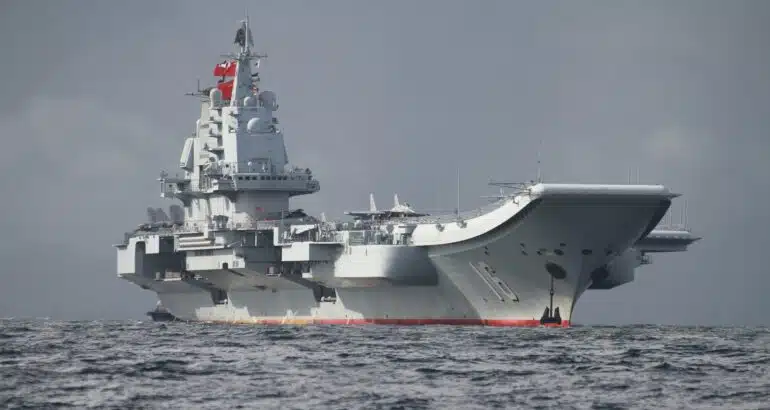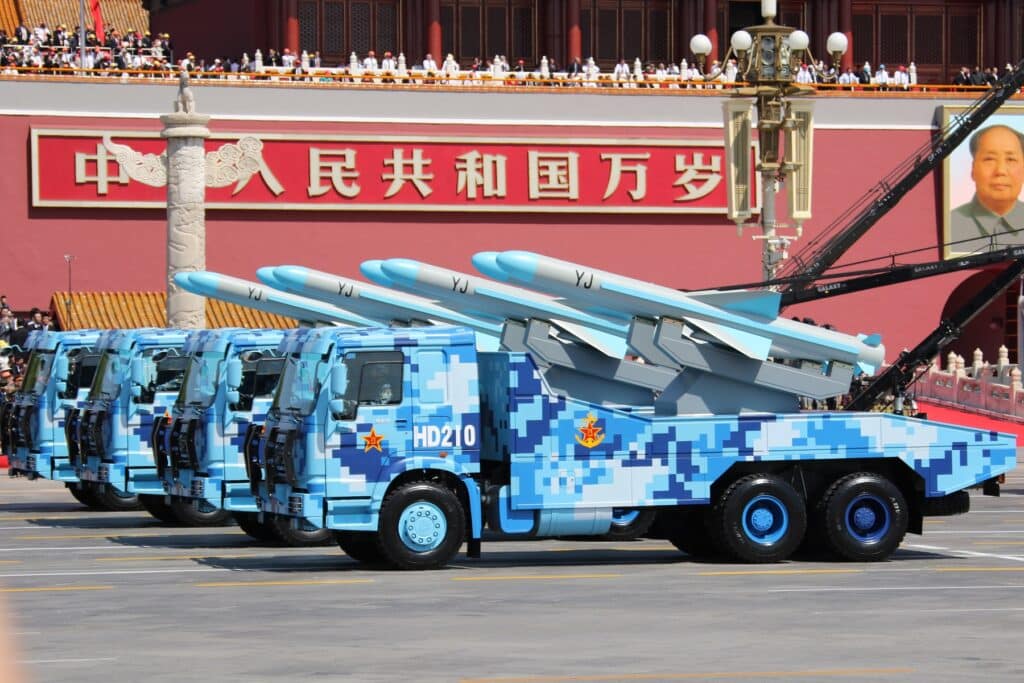Pentagon Assesses The PLA Navy’s Modernization And Growing Aggression
The Pentagon’s annual assessment of the People’s Liberation Army (PLA) – entitled the 2023 Report on Military and Security Developments Involving the People’s Republic of China – was published on 19 October.
Gordon Arthur 27 Oct 2023
This eagerly awaited document was damning in its analysis of the Chinese military’s behaviour:
“Over the last 18 months, the PLA appears to have been engaged in a centralised, concerted campaign to perform these risky behaviours in order to coerce a change in lawful US operational activity, and that of US allies and partners.”
It highlighted an alarming trend of aggression as Beijing wields the PLA as a
“capable instrument of statecraft”. The US DoD warned:
“Throughout the year, the PLA adopted more coercive actions in the Indo-Pacific region, while accelerating its development of capabilities and concepts to strengthen the PRC’s ability to ‘fight and win wars’ against a ‘strong enemy’, counter an intervention by a third party in a conflict along the PRC’s periphery, and to project power globally.”
These conclusions were underscored just two days later when a swarm of China Coast Guard and Maritime Militia vessels deliberately
obstructed Philippine vessels, even colliding with one, in the vicinity of Second Thomas Shoal in the South China Sea. The Philippine vessels were there to resupply the garrison on the beached BRP
Sierra Madre.
The report called out Beijing for its hypocrisy.
“The PRC has long challenged foreign military activities in its EEZ in a manner that is inconsistent with the rules of customary international law … However, in recent years the PLA has begun conducting the same types of military activities inside and outside the First Island Chain in the EEZs of other countries, including the United States. This activity highlights the PRC’s double standard in the application of its interpretation of international law.”
Quite apart from the illegal and dangerous activities of the PLA and sister agencies, the Pentagon report digs down into significant developments in the PLA Navy (PLAN). It noted that it is developing into a global force,
“gradually extending its operational reach beyond East Asia into a sustained ability to operate at increasingly longer ranges”.
It assessed:
“The PLAN’s ability to perform missions beyond the First Island Chain is modest but growing as it gains more experience operating in distant waters and acquires larger and more advanced platforms.” Experience comes through extended task group deployments in the Western Pacific and a continuous presence in the Gulf of Aden.
PLA Navy: The largest Navy in the world
This is a Type 052C destroyer, which was subsequently succeeded in Chinese shipyards by the even more modern Type 052D. (Gordon Arthur)
The PLAN is numerically the largest navy in the world,
“with an overall battle force of over 370 ships and submarines, including more than 140 major surface combatants”.
What is astounding in this statement is that the total number has risen 30 from the 340 vessels listed in the 2022 report. Nor does this include 60
Houbei-class missile boats. With 140 major surface combatants listed, this number has expanded by 15 compared to 2022. Note that the report essentially covers developments till late 2022 or early 2023.
The Chinese naval fleet is
“largely composed of modern multi-mission ships and submarines,” and there is little let-up in production either. The US DoD confirmed that more Type 055 cruisers are under construction, plus a fourth Type 075 LHD likely began construction earlier this year. The report also mentioned the new
Type 054B frigate, which the USA is calling the
Jiangkai III class.
Last year, the PLAN launched China’s third and most capable aircraft carrier, the future CV-18
Fujian. It also noted that the third Type 075 LHD was commissioned in October 2022. A growing carrier fleet extends air coverage of deployed task groups, with China now in the beginning stages of a multi-carrier force. Meanwhile, large amphibious ships enable a wide range of expeditionary operations to protect or advance Chinese interests.
With such unrelenting shipbuilding activity, the Pentagon estimates the PLAN will have 395 vessels by 2025, and 435 by 2030. Although this latter figure is down by five compared to the 2022 report, the figure for submarines has actually increased. For the submarine fleet, the Pentagon lists a figure of 65 submarines by 2025, and 80 by 2035.
Growing submarine fleet
The PLAN has six Type 094 nuclear-powered ballistic missile submarines, but China’s submarine fleet is growing strongly. (Chinese MND)
Indeed, China’s submarine fleet receives a significant amount of attention in the
2023 Report on Military and Security Developments Involving the People’s Republic of China. It listed a dozen nuclear-powered boats and 48 conventional submarines. Previously, the US said that
Jin-class Type 094 SSBNs were “likely” performing at-sea deterrence patrols with mated nuclear warheads. This year, however, the report confirmed that six Type 094s are actually performing these patrols.
Furthermore, these Type 094s can carry both JL-2 and JL-3 submarine-launched ballistic missiles to give China its
“first viable sea-based nuclear deterrence”. The USA clearly believes the JL-3 is fully operational. With a claimed range of 5,400nm, JL-3 missiles could reach the continental USA if launched from Chinese littoral waters. In contrast, a Chinese SSBN armed with JL-2s would need to be in the mid-Pacific for the same target.
Moving beyond the Type 094, the next-generation Type 096 SSBN
“is expected to enter service in the 2020s or early 2030s”. Indeed, construction is likely to start
“in the near future”, a fuller description that is appearing for the first time. Interestingly, it alleges that two Type 093B SSNs were launched at Huludao shipyard between May 2022 and January 2023.
The number of
Yuan-class conventional submarines is estimated at 21, which suggests that four new ones were completed last year.
More capable ships
Chinese warships and submarines are armed with modern missiles and weapons. Pictured here is the YJ-18 anti-ship and land attack cruise missile. (Gordon Arthur)
Not only are Chinese ship numbers growing, but they are gaining more capability.
“In the near term, the PLAN will have the ability to conduct long-range precision strikes against land targets from its submarine and surface combatants using land attack cruise missiles, notably enhancing the PRC’s power projection capability.” Modern warships are thus armed with missiles like the YJ-62, YJ-18A and YJ-12A. Worryingly, the report alludes to Chinese efforts to fit the YJ-18 into commercial shipping containers for
“covert employment aboard merchant ships”.
The Chinese navy is progressing in joint operations too.
“The PLAN is emphasizing maritime joint operations and joint integration with the other branches of the PLA. This modernization aligns with the PRC’s growing emphasis on the maritime domain and increasing demands for the PLAN to operate at greater distances from mainland China.”
China’s response to the 2023 report
As expected, China’s Ministry of National Defense reacted angrily to the Pentagon’s assessment. Spokesman Senior Colonel Wu Qian said on 25 October that the report
“distorted China’s national defence policy and military strategy, exaggerated and sensationalized the non-existent ‘China military threat’, and speculated about China’s military development…”
Wu insisted
“China needed to build a strong military for today’s severe and complex international security environment”. He also warned that the PLA
“had the confidence and ability to defeat any external interference and separatist attempts for Taiwan independence, and achieve the complete reunification of the motherland”. Chinese intentions are very clear. The PLA is pursuing a counter-intervention strategy to deter or prevent the USA from getting involved in any Taiwan scenario. The US is well aware of these aims to
“restrict the United States from having a presence in the East and South China Sea regions – within the First Island Chain – and increasingly to hold at risk US access in the broader Indo-Pacific region”.
The Chinese Navy (PLA Navy) continues to grow in size and capabilities, according to the latest Pentagon report on China's military.

www.navalnews.com








